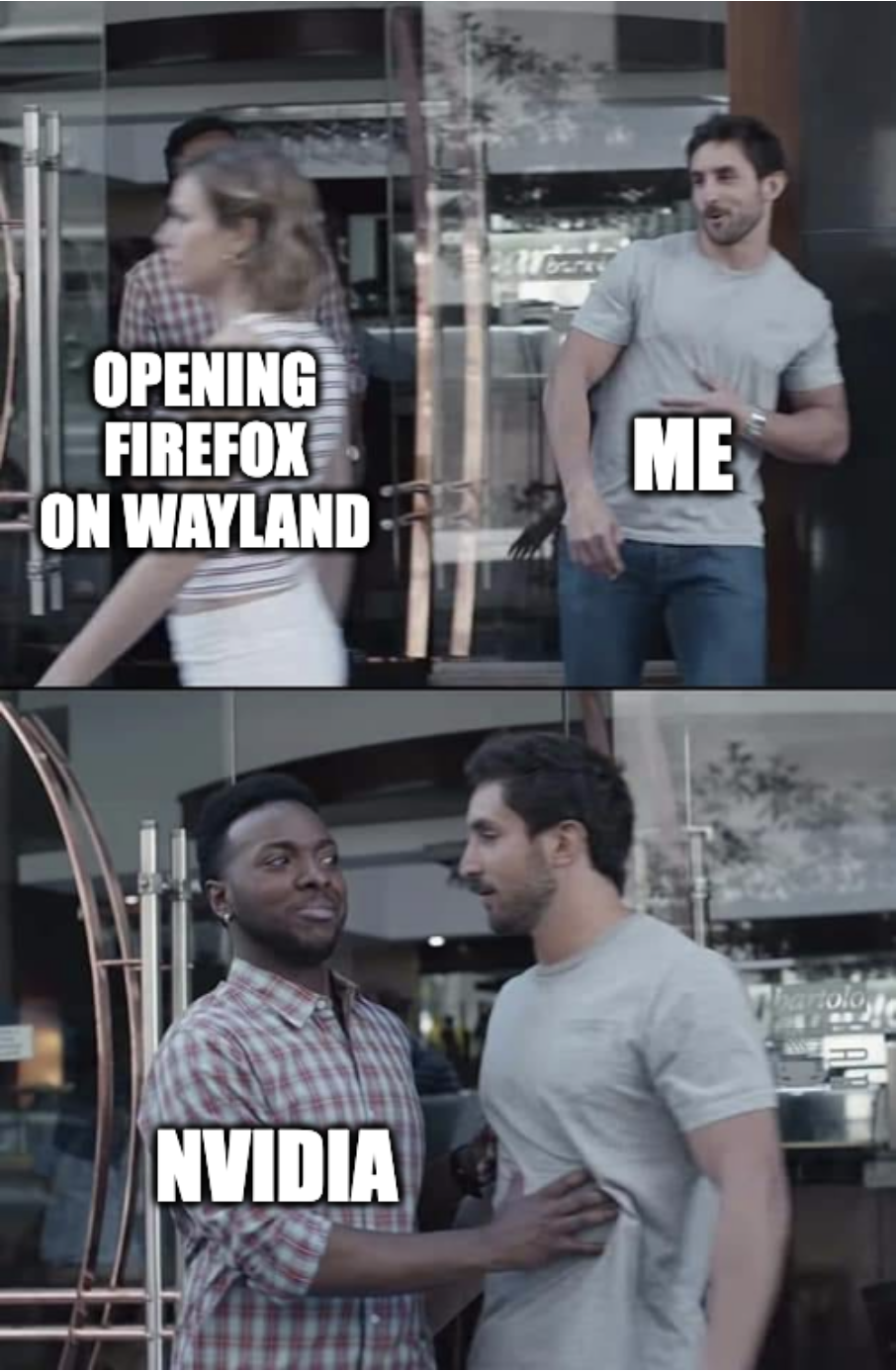It’s really ironic and embarassing. The most valuable chip manufacturer in the world, thanks to advances in AI and AI research, which is usually done using Linux systems. And yet Nvidia still sucks hard when it comes to Linux support.
Nvidia graphics support.
Their money is in headless systems, which TBF are much less problematic with Nvidia. Anything CUDA is first class on Linux with Windows as an afterthought.
1000% on the money here. You want encode, decode, calculation, acceleration? They got it. Rock solid, beautiful and simple. You want that shit to actually SHOW UP ON SCREEN? Get the fuck outta here. What do you think nVidia is, a GRAPHICS CARD company!?
You want that shit to actually SHOW UP ON SCREEN? Get the fuck outta here. What do you think nVidia is, a GRAPHICS CARD company!?
I pray for no blackscreen after every update, and I’m not even using it! It’s hooked up to an AMD IGP!
CUDA always works though, lol.
Anything CUDA is first class on Linux with Windows as an afterthought
Not in my experience.
You also need the damn driver to work for CUDA. Nouveau doesn’t cut it for that.
I wouldn’t call their Windows support stellar, either. There’s only one error code for any and all problems and RTXes can be damn finicky if you’re unlucky.
Latest kernel, wayland, NVIDIA dGPU greater than RTX 900, latest proprietary NVIDIA driver and correct vulkan packages for said driver:
Don’t see any issues, really
What does not work?
Maybe some install steam and choose wrong vulkan dependency 🤔
Or have vulkan dependency for nouveau installed prior to switching to nvidia drivers
I just wonder why pacman not automatically chooses the correct dependency 😅 but I am sure there is a reason
This is why I don’t update Nvidia drivers unless there’s a fix I need. If it’s stable, that’s all I want.
Until the GPU cooks itself anyway, because nvidia can’t admit their new power connector was a mistake.
Seems to be less about the connector, but more about load balancing. The German guy who had 150°C connectors at the PSU side also measured current draws. One cable was doing 22 A (so almost half of the 5090’s total consumption) while the other
7five were just chilling.Nvidia connected all six cables like they were one and have no way to measure or balance the load across all six.
They used to do load balancing on the 30 series, treating it as 3 cables basically (3x2 cables).That’s true, but once my apartment is on fire, I don’t really care if it was the cable or the connector.
My insurance might be interested, though.
You’re never gonna push the technological envelope with that attitude, bro.
That’s fine.
How about both?
I’d expect the design to take into account this kind of issue, they’re only one of the most valuable companies in the world, surely they can afford some QA.
Surely that’s fixed by now, right? SURELY
Don’t worry, Nvidia got you covered: it also likes to occasionally break with kernel updates.
Some people “I don’t care why it doesn’t work, it’s Linux’s fault!”
Not just some…
They should just buy a PC build for linux with it preinstalled
Like, tuxedo, system67(or whatever number they have) or I think framework is available like that as well.
Except all those Linux specific privacy/modularbility orientated PCs are expensive as hell with base models starting close to 1k last I checked. They’re aimed at the demographic of cushy tech nerds making bank tapping at a keyboard who care about opsec or right to repair and can comfortably afford dropping 1k on a new laptop without thinking twice about if that money has better uses.
I and many others who don’t live in economic lah-lah land will NEVER be able to justify 1k spent on a laptop just because it has physical kill switches or modular parts and preloaded with a good Linux distro. These companies need to touch grass and come down a couple hundred dollars to the 400-500$ range then we can talk. Until that day comes, the guy selling librebooted thinkpads on eBay running popos or mint is the better option for those who live with the reality of not having a lot of money.
I think, that it is good having high end offerings for “Linux first PCs” and agree that there is a lack of market for midrange “Linux first PCs”
A sub-brand offering good quality hardware in cheap case / outdated HW in good case would be nice. So they could keep their high end branding intact, but still profit from people with low budget
(For low end, there is raspberry pi and gang)
Time to create a startup 😉 i think, you with your knowledge would be entitled.
but on the other hand if we tell you to use an used Thinkpad you won’t like that either right ?
Oof bad guess. my daily driver is a used t460 made in 2015 running Mint. I said that used librebooted thinkpads are a great option to inexpensive preinstalled Linux machines. Are you sure you replied to the right person? Or are your reading comprehension skills fucked? Either way better luck next assumption
Its not just Linux. NVIDIA sucks on windows too, but those PCMR types aren’t willing to admit it.
They’re the ATI drivers of this century.
Ptsd rewakens
Newer Linux users will never have to endure the pain of fglrx.
Yeah, I don’t buy nvidia for this exact reason. No amount of performance matters if the drivers are broken
What does not work for you? And which nvidia GPU?
Last nvidia gpus I owned were water-cooled GTX 670s in SLI back when I ran windows. Ever since then I’ve always chosen AMD or intel, because of the in-kernel drivers.
I see, yea those cards are extremely bad supported by nvidia and are only usable with nouveau in my opinion. But nouveau got pretty good, and was the first GPU I owned that worked with wayland well (have an old MacBook for funnsys running arch with a nvidia at about that age)
But the “newer” cards (like rtx stuff) are working very good with wayland now in my experience (rtx 980 in my Desktop)
But in kernel is still way better, 😌 nvidia driver updates always take so long to install
Yeah, I had to exchange my laptop for another one with an AMD GPU because Wayland was so broken, and I was getting serious input lag in games, even on X11.
And this was a few months ago. NVK worked a bit better, but compatibility wasn’t great, and performance was about 50% of the proprietary driver.
Just upgraded my EndeavourOS (Arch btw) and saw Nvidia driver update. Reboot, KDE came up successfully, OK, good. Play game, stuttering right on the title screen. 😑
From my idiot troubleshooting with Nvidia in the past, I disable “Allow screen tearing in fullscreen windows.” Test, runs perfectly now. The funny thing is that I had to enable that option in the past to make the same stuttering go away. 🤷♂️
Someone suggested maybe that option doesn’t matter and I just had to start the game multiple times because of shader cache? IDK, but I do know that my next card will be AMD.
Modern Proton versions should compile shaders beforehand, I know what you describe from when it had to do it in realtime. If it happens again try clearing the Shader Cache in the Steam Settings or switch to a newer Proton version.
Thanks! Like I said I got it running but it’s a bit of a mystery. If you are interested, here’s where I gave up on Mint Debian for gaming because I couldn’t fix the same problem on the same PC.
Hardware is known to be good. Greatly enjoying EndeavourOS and I wanted to get familiar with Wayland and some newer software anyway.
How? I have a 4060ti and it works well enough on wayland
Which distro? You perhaps lucked out so far. Anyone using Linux for multiple years can attest for the trash that are Nvidia drivers, especially once you compare it to AMD (who, outside of professional applications, usually don’t need any driver install or setup at all).
I’m not that person but I impulse switched to Garuda (Arch-based) around 8 months ago with a 3080 and everything has just worked, the only thing I’ve had problems with is flatpak being the bane of my existence
Yeah same, 4070 ti super on garuda, no issues.
Interesting, and good to hear they’ve managed so far. So far my “career” included Ubuntu, Mint, Arch, Debian, Pop!_OS and OpenSuse. At one point or another the Nvidia drivers were a pain on all of them except Pop!, they circumvented most problems most likely due to their approach of maintaining an (almost) dedicated Nvidia build of their distro. Something they can specifically afford given they sell devices with those cards and got people working on this stuff 24/7.
Funnily enough Flatpak works for me like a charm. 😅
Oh, flatpak works great for me, it’s just that it’s too sandboxed and I inevitably need something to talk to something else and rather than learn to use flatseal I just gave up and installed the AUR versions of everything
I haven’t had any problems on Linux Mint with a 3060 Ti aside from some artifacting when I try to do screen recordings (unless I disable flipping).
EDIT: I’ve had that GPU for about 2 years. I had a 1050 Ti for about 4 years before that.
Actually now that I think about it an update did break my graphics at one point, but that might’ve been partially my fault. I just reverted and reinstalled the same update right after though, and that worked just fine, so it wasn’t a huge deal.
Overall I would say its been more than 10 years since I’ve had an actual major graphics issue (having to open xorg.conf).
I just used Ubuntu because it’s supposed to be the main/most used distro
Fk me. I just saw an Nvidia package in my apt upgrade. Am I going to be screwed ?
No, just upgraded from a working computer to an up to date not working computer.
Timeshift time
The best thing I ever did was configure prime offloading so basically everything but games runs on my integrated graphics.
Still borked my graphics a few times setting that up, but I’m on nixos so it wasn’t a big deal.
But before:

I didn’t have any luck with PRIME. On my work laptop, I want to use Intel graphics when using the laptop screen, and Nvidia only when plugged in to external monitors. Couldn’t get it working properly at all - the external monitors only work properly when hybrid graphics is disabled in the BIOS.
Yeah, I’ve only ever heard bad luck when it comes to prime and laptops. Usually, like you mentioned, due to limitations imposed in the BIOS.
I’m wanting to switch my gaming PC to mint from Windows. I’m new to Linux, that’s why I’m going with mint. What GPU should I buy for my use? (RTX is not important to me. I just need it to play my games well)
deleted by creator
I had a ton of trouble getting my R9 390 working on Linux, so ymmv
I think that card fell right in the gap when the switch from the older Radeon driver to amdgpu happened (or sth. across those lines, I sometimes see that exact architecture needing some love to run nicely). Didn’t had any issues with anything from RX 550 upwards ever since amdgpu became the default.
Ah, that would make sense. Too bad I had to upgrade to Nvidia since I do 3D modeling.
What does 3D modeling have to do with that?
CUDA cores
I have a RTX 3050 mobile with Intel cpu laptop. So far… Everything works fine on fedora and arch. I haven’t installed Debian based on it however
I know mint is often said to be the friendly new distro.
I’ve heard good things about Bazzite. Like really good things.I’m currently running Endeavour OS. As soon as I get a chance, I’m planning on checking out Bazzite.
If you are going in fresh, I think Bazzite is something to try for a week or so.
I can vouch for Bazzite and always will as long as they keep up the solid work. Running on a laptop (gnome variant for easier fingerprint login) and desktop (KDE, cuz I just prefer KDE day to day). It just works™️.
Thanks. I’ll go check it out.
Honestly they both suck in different ways, which also means that unless you’re quite unlucky, they both mostly work fine.
I swapped my gaming PC from Windows to PopOS a few months ago and it’s been a seamless experience with driver installation with an Nvidia GPU / AMD CPU
Installed and played Civ 7 perfectly yesterday.
RX 9070 when it comes out, Mint is good but there are so many good options. I suggest using cachyos and trying out all the DEs so you pick something you like. Although you don’t have to stick with CachyOS if you don’t want to.
What does DEs stand for? I’m very new to Linux.
A mistake people make very often is to conflate the distro with a “look” or “theme” to the UI, and it’s not their fault.
Distros bundle a desktop environment which contains many applications used to navigate the computer graphically with things like “file managers” such as Windows explorer for example.
A DE can bundle lots of programs or very few and these programs differ in looks and functionality, not only that but these programs can be installed / uninstalled regardless of what distro you’re using.
In short: distro doesn’t affect DE but must distros bundle a DE based on things like philosophy, functionality or maybe just looks.
There are many DEs which is why I suggested installing CachyOS as part of the installation shows you options, you can try them out rewipe the drive, try out another one in less than 3 minutes. So it’s the perfect sandbox environment to try new things. I guess you can use VMs as well, not sure how well cachyos works on VM.
As a personal note on DEs when I first used Linux about 5 years ago I used KDE plasma because I thought it was the most windows-like. But I had many issues with KDE, chances are if you use your search engine you’ll see similar complaints about it which I likely share.
5 years in the future my favourite DE is basically using Sway and a file manager like Nautilus. Sway has Swaybar as a status bar and that’s really all I need.
Not sure if Sway counts as a DE though, I think it’s a window manager first and foremost.
Thank you. Looks like I have some homework to do. I’m getting excited, I’ve been reading a bunch about Linux and there are sooo many options. I’m barely started and already loving Linux.
My piece of advice if you have 2 drives, and this goes for any OS not just Linux.
- drive for your OS
- drive purely for storage. never store anything in the 1 drive except for user installed programs or updates.
that way you can wipe the first drive whenever you run into anything or you want to change anything without being worried about losing data
make sure your browser is using a password manager so stored passwords don’t vanish
DE is short for desktop environment. Essentially it’s the type of GUI you use. GNOME and KDE are the most popular, but there’s many others.
GNOME is the most common, while KDE is more powerful, very customizable, and will feel more like Windows (for example, it has a taskbar similar to the Windows one).
I’d recommend looking at screenshots, then trying some live DVDs and seeing what you like best. A live DVD is a Linux system you can boot from a DVD and try out without installing it. IMO one of the best ways to try several desktop environments is by using Fedora, since they have a bunch of different desktop environments available (see https://fedoraproject.org/spins ).
For a brand new user, I’d recommend Linux Mint. It’s a good distro for beginners.
I am this close to proposing to swap GPUs with my friend who’s coming this weekend for help building his PC. He’s using 6900XT and I’m using 3080 12GB. Technically it’ll be a downgrade but I’ll be free of fucking Windows.
Can I ask why they’re still the de facto? I run AMD on CPU and GPU and don’t consider purchasing otherwise when researching components (other than baseline for comparison and per cent cost)
Performance. AMD has explicitly stated that they aren’t even trying to compete at the top end.
NVidia got there early with their CUDA API.
That’s been around for decade(s), which enabled all sorts of crazy GPU usages beyond just graphics.
Due to that, NVidia held the datacenter/professional scene exclusively for a long time.
As a result, their professional cards and related drivers have been industry standard.
I have no doubt that AMD is better, but so much (non-mainstream) software is built against NVidia drivers, CUDA etc., that will be slow to change until the cost of implementing similar for AMD outweighs “just sticking with NVidia”.The classic “Nobody ever got fired for buying IBM”
If you need to use pytorch, ie predictive modelling using neural networks, you need to use NVIDIA.
And rocm stuff is catching up but, atleast a few years ago, massive pita.
Iktf, I had my 1060-6GB die and for a while I was gaming on a 750Ti lol.
Recently my Crucial 1TB SATA SSD suddenly died, no errors, no SMART, no detection on any computer or via USB adapter, only coil whine, taking with it exactly all the things I never backed up because SSDs are supposed to be good :(
SSDs at the end of their lifespan do tend to fail more gracefully than HDDs, as even when they become fully worn and unable to take new writes, they will often still allow reads.
But, that depends on the specific type of failure.
I had an SSD fail in the same way as yours, where the controller chip or something along the path there died, and it went from fully working to toast in an instant.
Some drives are more reliable, some drives are less reliable, but the only rule is that any drive can break, at any time, old or new.
Always have backups.
Yeah i should know, but I’m too lazy haha. Didn’t lose anything completely irreplaceable but my beautiful bind9 local DNS zone written and annotated by hand is gone.
Plus I have basically nowhere to back up to.
At least the first thing I did when reinstalling Debian was set up an an rsync cron job to fetch the home, etc and some other select dirs, but this is backing up to a Raspberry Pi with a busted micro SD slot that runs off a rather dodgy USB enclosure’d 120 gig mSATA SSD that already failed before that originally transplanted from a busted MSI gaming laptop I sold for coke cash in the mid-2010s.
Not ideal. That pi also periodically shits the bed. It’s exposed to the elements a bit because it’s also in use in 2 DIY iot projects.
Is there a decent non-shit non-megacorp-empowering affordable way of doing off-site backups on a small scale?
Sounds like you’ve got quite the esoteric setup, hehe :)
My personal solution isn’t exactly small as I have two identical four-disk NAS servers which operate with one as primary and the other as a read-only mirror of the primary. For off-site I don’t have an automated solution but just backup onto external every so often and leave it with a family member.
A good solution could be as simple as a raspberry pi with an external SSD at a friend or family’s place, and then make that accessible via VPN to your home network.
I can use gamescope once every time I update and then it fails every subsequent launch.
I just want to game in HDR, smh
The good thing about an nvidia driver update is that it forces you to take a backup. And hey, I figured out how
apt-fileworks just so I could figure out where the nvidia driver putnvidia-settings(as it forgot to put it somewhere $path could find it, and no .desktop files were made).













